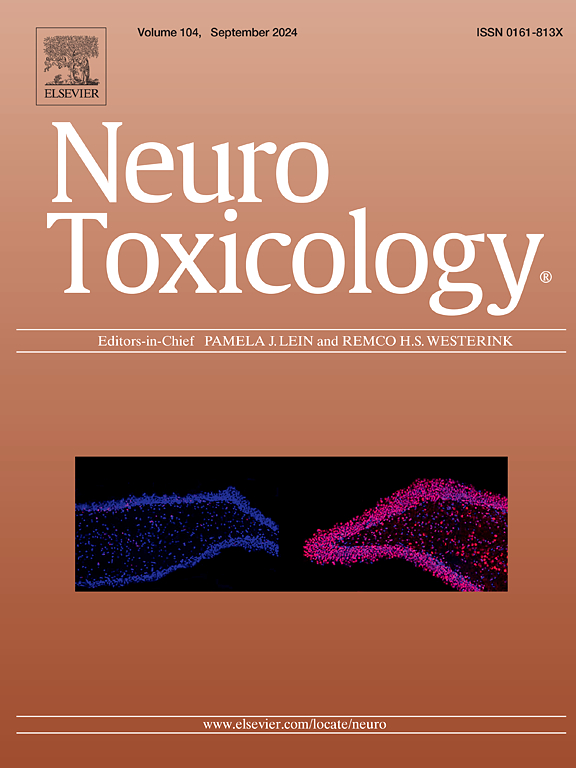百里醌对大鼠皮层神经末梢谷氨酸释放的抑制作用。
IF 3.9
3区 医学
Q2 NEUROSCIENCES
引用次数: 0
摘要
百里醌(TQ)是一种从黑草籽油中提取的天然化合物,具有神经保护作用。本研究探讨了TQ对大鼠皮质突触体谷氨酸释放的影响,并探讨其机制。TQ抑制4-氨基吡啶(4-AP)诱发的谷氨酸释放呈浓度依赖性,IC50估计为8.1μM。这种抑制作用在无Ca2+条件下和存在巴菲霉素A1(一种水疱性谷氨酸转运蛋白抑制剂)时不存在,表明Ca2+依赖性胞外机制。与此一致,TQ显著降低了4- ap诱导的synaptotagmin 1 luminal domain antibody (syt1-L ab)的摄取,证实了突触囊泡胞吐的抑制。此外,TQ在不影响突触体膜电位的情况下减弱了4- ap诱导的端内Ca2+升高。值得注意的是,TQ对谷氨酸释放的抑制作用通过阻断P/ q型Ca2+通道或抑制蛋白激酶C (PKC)而被消除。Western blot分析进一步显示,TQ降低了4- ap诱导的突触体中PKC、SNAP-25和Munc18-1的磷酸化。总的来说,这些发现表明,TQ通过减少P/ q型Ca2+通道的Ca2+内流,并随后下调PKC/SNAP-25/Munc18-1信号级联,抑制皮层突触体的谷氨酸分泌。本文章由计算机程序翻译,如有差异,请以英文原文为准。
Inhibitory regulation of glutamate release from rat cortical nerve terminals by thymoquinone
Thymoquinone (TQ), a natural compound derived from the oil of Nigella sativa seeds, has demonstrated neuroprotective properties. This study investigated the effects of TQ on glutamate release from rat cortical synaptosomes and explored the underlying mechanisms. TQ inhibited 4-aminopyridine (4-AP)-evoked glutamate release in a concentration-dependent manner, with an estimated IC50 of 8.1 μM. This inhibitory effect was absent under Ca2 + -free conditions and in the presence of bafilomycin A1, an inhibitor of vesicular glutamate transporter, indicating a Ca2+-dependent exocytotic mechanism. Consistently, TQ significantly reduced 4-AP-induced uptake of the synaptotagmin 1 luminal domain antibody (syt1-L ab), confirming suppression of synaptic vesicle exocytosis. Moreover, TQ attenuated the 4-AP-induced elevation of intraterminal Ca2+ without affecting synaptosomal membrane potential. Notably, the inhibitory effect of TQ on glutamate release was abolished by blockade of P/Q-type Ca2+ channels or inhibition of protein kinase C (PKC). Western blot analysis further revealed that TQ reduced 4-AP-induced phosphorylation of PKC, SNAP-25, and Munc18–1 in synaptosomes. Collectively, these findings suggest that TQ inhibits glutamate exocytosis from cortical synaptosomes by reducing Ca2+ influx through P/Q-type Ca2+ channels and subsequently downregulating the PKC/SNAP-25/Munc18–1 signaling cascade.
求助全文
通过发布文献求助,成功后即可免费获取论文全文。
去求助
来源期刊

Neurotoxicology
医学-毒理学
CiteScore
6.80
自引率
5.90%
发文量
161
审稿时长
70 days
期刊介绍:
NeuroToxicology specializes in publishing the best peer-reviewed original research papers dealing with the effects of toxic substances on the nervous system of humans and experimental animals of all ages. The Journal emphasizes papers dealing with the neurotoxic effects of environmentally significant chemical hazards, manufactured drugs and naturally occurring compounds.
 求助内容:
求助内容: 应助结果提醒方式:
应助结果提醒方式:


